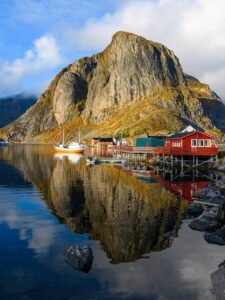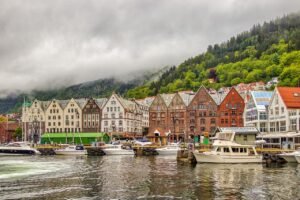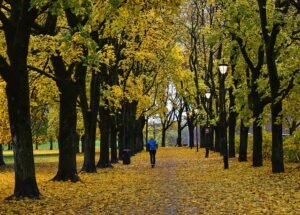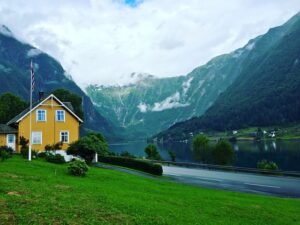

The Best of Norwegian Cuisine: Summer Food Festivals and Local Dishes
Norway’s culinary scene comes alive in the summer with a host of food festivals showcasing local Norwegian dishes. The cuisine deeply reflects Norway’s regional differences, historical fishing and farming practices, and traditional preservation methods like curing, fermenting, and drying replete with unique ingredients found only in its rich landscape.
These summer festivals provide the perfect platform to experience everything from freshly harvested seafood to homemade gravlaks, from måltid of smoked meats to farm-to-table offerings, all enjoyed against the backdrop of the breathtaking Norwegian outdoors. The seafood is a significant part of Norwegian cuisine due to the country’s history of fishing and farming practices1. These events not only display the culinary ingenuity of Norwegian chefs but also highlight traditional Norwegian foods which tend to be the most expensive options in restaurants1. However, similar quality food can often be found at fish market restaurants or traditional Norwegian cafés1. Alfresco dining in Norway, especially during Summer, elevates these festivals, making the experience of indulging in Norwegian summer food festivals truly memorable.
Table of Contents
ToggleIntroduction to Norwegian Cuisine
Norwegian cuisine is a distinctive symphony of flavors shaped by its long coastline, short summers, and vast forests. These Norwegian cuisine characteristics highlight the profound connection with nature that is evident in the country’s food traditions. The staple ingredients include locally sourced meats such as lamb and pork, often paired with game.
Seafood is integral to Norwegian cuisine, with preservation methods like drying, fermenting, and curing playing a pivotal role. Notable dishes like fish soup, especially popular in Bergen, showcase the regional propensity for rich, flavorful broths coupled with vegetables and various fish types1.
Seasonal dishes are prominent in Norway, reflecting the importance of fresh, locally available produce, which aligns with the broader Scandinavia culinary traditions. For example, the national dish, fårikål, consisting of lamb or mutton, cabbage, water, and peppercorns, is celebrated on Fårikålens Dag, the last Thursday in September12. This celebration underlines the pride Norwegians take in their seasonal Norwegian cuisine.
| Dish | Ingredients | Season | Region |
|---|---|---|---|
| Fårikål | Lamb, cabbage, water, peppercorns | Autumn | Nationwide |
| Pinnekjøtt | Lamb ribs, salt | Christmas | Western Norway |
| Raspeballer | Potatoes, stock, fatty meat | Summer | Nationwide |
Bergen, with culinary traditions dating back 750 years, exemplifies the depth of history in Norwegian cuisine2. The consistent use of hearty vegetables and rich sauces in traditional dishes showcases the cuisine’s seasonal adaptability. Additionally, 20% of Norwegians include lutefisk as part of their Christmas dinner, celebrating their unique way of preserving fish1.
The Norwegian cuisine characteristics are also complemented by delicious dairy products like brunost cheese, an innovation that began in 1863. The tradition of making heart-shaped waffles, now over 150 years old, remains cherished, with waffles typically cooked within 2-4 minutes in a specialized waffle iron2. This combination of ancient methods and seasonal awareness creates a tapestry of flavors that epitomizes the essence of Scandinavian culinary traditions.
Summer Food Festivals in Norway
Summer in Norway is a vibrant season filled with traditional Norwegian food festivals and exciting Norway summer culinary events. One of the standout occasions is the Trøndersk Food Festival, which features food from over 200 local producers and offers a variety of cooking courses3. Visitors can expect more than just good food; they can engage in hands-on experiences such as cooking courses and educational activities at the Children’s Food Festival3.
For beer enthusiasts, the Brewery Festival is the perfect event, showcasing freshly brewed beer from microbreweries in Trøndelag and Norway, with participation from breweries across Europe3. Those who love cider should not miss the Hardanger International Cider Festival, which offers seminars and cider tastings4.
The Gladmat Festival in Stavanger is a crowd-puller, attracting as many as 250,000 visitors annually; it offers food sampling from over 100 stands and producers and includes programs for all age groups34. This festival is a melting pot of niche products and international dishes that cater to a wide array of tastes and preferences3.
Fishing traditions and regional dishes dominate the SMAK: Northern Norwegian Food Festival, where cloudberries in various forms and an array of Northern Norwegian dishes take center stage3. Meanwhile, those interested in foraging traditions can head to the Foraging Festival in Hjelmeland in Ryfylke, which celebrates the region’s foraging heritage, though the exact date for 2024 is yet to be set3.
Another unique event is the Midt i Matfatet Festival, which plays host to the Norwegian Championship in potato peeling, an event that underscores the centrality of potatoes in Norwegian food culture3. Additionally, the Shellfish Festival in Mandal, established over 30 years ago, is held on the second weekend of August each year and celebrates Norway’s rich shellfish traditions4.
The Norwegian Rakfisk Festival in Valdres, starting in November, includes live music and locally sourced food, offering a delightful mix of traditional and modern culinary delights4. Whether it is through seafood extravaganzas in coastal towns or inland festivals showcasing game and meat, these traditional Norwegian food festivals provide unforgettable experiences that capture the essence of Norway summer culinary events.
Oslo Food Festival: A Culinary Delight
The Oslo Food Festival is a vibrant celebration that draws food enthusiasts from all over. Highlighting the city’s diverse culinary scene, it captures the essence of Norwegian gastronomy through a variety of interactive and engaging events.
Event Highlights
Visitors to the Oslo Food Festival can look forward to a plethora of activities designed to tantalize the taste buds and educate the senses. The festival features cooking demonstrations by renowned chefs, offering insights into the techniques behind some of Norway’s most beloved dishes. Attendees can participate in tastings, where they savor a range of culinary delights from local and international cuisines. Additionally, culinary tours take groups through Oslo’s bustling food scene, showcasing everything from farm-to-table restaurants to trendy street food stalls.
Must-Try Local Dishes
The festival is an excellent opportunity to experience must-try Norwegian dishes that reflect the diversity and creativity of contemporary Oslo cuisine. Items such as cured gravlaks, an iconic Norwegian specialty, and smoked salmon, revered for its delicate flavor and rich texture, are popular choices among festivalgoers. Another highlight is the tender meatballs, which embody traditional Norwegian flavors while offering a modern twist. These dishes are not just a treat for the palate but a testament to Norway’s culinary heritage.
Moreover, the Matstreif food festival, held annually in Oslo at Rådhusplassen, brings together producers from across the country, enriching the Oslo food festival experience even further by showcasing an expansive array of Norwegian delicacies4. Whether you’re a local or a visitor, the culinary delight Oslo has to offer during the festival is an unmissable experience.
Bergen Seafood Festival: A Celebration of the Sea
The Bergen Seafood Festival, held annually in the summer, is a vibrant Norwegian seafood celebration that draws food enthusiasts from around the globe5. This event is a testament to Bergen’s rich seafood heritage, which dates back centuries5. Attendees can savor a plethora of fresh Norwegian seafood such as smoked and fresh cod, stockfish, and King Crab, all expertly prepared by renowned chefs in front of their eyes5.
The festival offers a variety of seafood dishes, catering to different tastes, showcasing both traditional Norwegian seafood classics and innovative fusion creations5. This emphasis on fresh Norwegian seafood, directly sourced from the surrounding waters, ensures the highest quality and flavor5.
Sustainability is a key theme at the Bergen Seafood Festival. The seafood served is either caught or farmed sustainably, reflecting Norway’s commitment to sustainable seafood practices56. Local fishing regulations in Norway limit the amount of fish caught, their size, and the fishing methods used, which further underscores the country’s leadership in global sustainable seafood practices6.
The main event of the Bergen Seafood Festival takes place at the world-famous Fish Market, known for its exceptional quality and taste6. In addition, the festival includes interactive exhibits and demonstrations about Norwegian seafood heritage, providing attendees with a deeper appreciation for the region’s culinary traditions5.
Beyond seafood, the festival is a cultural extravaganza featuring traditional music and dance performances, local crafts, and artworks5. Visitors can also partake in cooking workshops to learn how to create exquisite seafood dishes themselves, making the Bergen Seafood Festival a comprehensive and enriching Norwegian seafood celebration5.
Scandinavian Food Culture and Alfresco Dining in Norway
The Scandinavian food culture deeply celebrates the joys of alfresco dining, an integral part of summers in Norway. With a coastline of approximately 100,000 kilometers, Norway’s cuisine boasts a rich history influenced by the sea7. This historical connection is evident in traditional Norwegian dining history, where dishes like lutefisk and stockfish have been cherished for centuries7.
History and Influence
Alfresco dining in Norway has evolved with the seasons, reflecting the country’s agricultural and maritime heritage. Traditional methods like air-drying and fermenting fish, exemplified by lutefisk and rakfisk, showcase the ingenuity of Norwegian dining history7. The production of gamalost, an old cheese dating back to Viking times, signifies the labor-intensive food practices that have shaped the Norwegian palate7. Moreover, the modern culinary scene, as highlighted by celebrated restaurateurs such as those at Mathallen Tromsø, continues to blend traditional Northern Norwegian dishes with global influences8.
Popular Alfresco Dining Spots
Norway offers an abundance of picturesque spots perfect for alfresco dining, capturing the essence of Scandinavian food culture. The restaurant Kvitnes Gård is renowned for its 25-course dining experience that includes unique snacks from the forest and sea, making it a must-visit for those keen on exploring the rich spectrum of Norwegian cuisine in an outdoor setting9. Then there’s the scenic journey aboard the MS Nordkapp, where passengers can relish Chef Halvar Ellingsen’s creations, further enhancing their Norwegian dining experience9.
For those visiting Tromsø, venues like Fiskekompaniet and Riso mat & kaffebar provide varied options for alfresco dining. Fiskekompaniet offers fresh, sea-inspired dishes alongside stunning harbor views, while Riso mat & kaffebar delivers a cozy atmosphere with European and Scandinavian cuisine8.
Incorporating these delightful spots into your itinerary promises a memorable engagement with alfresco dining in Norway, whether it’s enjoying unique dishes in restaurants like Kvitnes Gård or savoring the regional flavors in Tromsø amidst breathtaking natural backdrops.
Traditional Norwegian Dishes to Savor
Norwegian cuisine is renowned for its focus on traditional dishes that have stood the test of time, reflecting the country’s rich cultural heritage and seasonal variations.
Fårikål: The National Dish
Fårikål, a staple in Norwegian households, is often heralded as the nation’s favorite dish. This comforting lamb stew, slow-cooked with cabbage and whole black peppercorns, is particularly enjoyed during the autumn and winter months10. Its status as the national dish underscores its popularity across the country1. The simplicity of the ingredients used in fårikål highlights Norway’s reliance on local produce and traditional cooking methods to create hearty and delicious meals1.
Raspeballer: A Summer Favorite
In contrast to the hearty fårikål, raspeballer, also known as potato dumplings, shines as a summer delight. These dense potato balls are simmered in savory stock and often paired with fatty cuts of sheep or pork, embodying the essence of traditional Norwegian dishes1. Raspeballer is enjoyed particularly on Thursdays throughout Norway, showcasing its deep-rooted cultural significance10. As a beloved summer dish, raspeballer exemplifies the country’s love for simple yet satisfying comfort food, perfectly suited for the warm season1.
Exploring Local Norwegian Ingredients
Delving into the realm of local Norwegian ingredients unravels the essence of traditional Norwegian cooking. These elements are deeply rooted in the regional Norwegian flavors that have defined the country’s cuisine for centuries. Norway’s cooler climate creates some of the best-tasting strawberries during the berry season, cherished for their sweetness and juiciness11. Additionally, cloudberries, a highly sought-after wild berry, are used to create delightful jams and the beloved treat multekrem, further emphasizing the importance of seasonal ingredients in Norwegian gastronomy11.
The diverse and expansive Norwegian landscape offers an array of ingredients that enrich regional Norwegian flavors. From reindeer meat dishes like bidos and finnbiff, popular in Northern Norway among the Sami people, to the revered fish dishes such as stockfish (tørrfisk), which holds significant cultural importance, it is evident that local Norwegian ingredients play a pivotal role in the culinary narrative11. Brunost, or brown cheese, is another quintessential Norwegian product, originating in 1863 thanks to Anne Haav in the Gudbrands valley, and celebrated for its unique caramelized flavor and wonderful texture2.
Emphasizing regional differences, traditional Norwegian cooking often involves utilizing locally available produce and traditional preservation techniques. Rakfisk, a fermented fish dish, enjoys immense popularity in November with dedicated festivals held every weekend, showcasing Norway’s proficiency in preserving fish through fermentation11. Moreover, the naturally abundant reindeer and game, paired with indigenous berries and fresh seafood, define the traditional and contemporary palates across the nation.
A staple in Norwegian cuisine, fish cakes such as fiskekaker, commonly served with boiled potatoes and gravy, are a testament to the integration of local Norwegian ingredients in everyday meals11. With a rich dairy tradition, it’s not surprising that the average Norwegian consumes 40 gallons of milk annually, highlighting the significance of dairy, not just for milk but also for iconic foods like brunost2. As one explores the myriad of native ingredients and traditional food preparations, it becomes clear how integral they are to the preservation and propagation of regional Norwegian flavors.
“The essence of Norway’s cuisine lies in its rich local flavors and traditional cooking methods, refined over generations,” says renowned Norwegian chef Andreas Viestad. His perspective aligns perfectly with the country’s cherished culinary customs.
Farm-to-Table Norse Flavors
Farm-to-table Norse flavors emphasize the core principles of sustainable Norwegian cuisine, highlighting a commitment to reducing food miles and supporting local agriculture.
Focus on Sustainability
Sustainability is a cornerstone in the farm-to-table Norse flavors movement. Fresh produce in Norway, such as the country’s renowned strawberries, benefits from the colder climate that allows the berries to mature slowly, intensifying their sweetness11. The nation prides itself on practices that ensure long-term environmental health and food security.
Fresh and Seasonal Produce
Norwegian cuisine thrives on fresh produce, with a deep respect for what’s in season. For instance, cloudberries, also known as “multebær,” are a prized delicacy that reflects the bounty of Norway’s natural landscape11. From Brunost cheese made by caramelizing whey in cow’s or goat’s milk to the celebrated national dish, fårikål, made of lamb and cabbage, the emphasis on local ingredients is undeniable11. The festivals celebrating these foods—such as the annual event for Rakfisk, a fermented fish delicacy—underscore the importance of seasonal and sustainable eating in Norwegian culture11.
Norwegian Seafood Specialties
Norway’s seafood heritage is a cornerstone of its culinary fame. With a vast 100,000-kilometer coastline shaping its distinctive cuisine, it’s no wonder that a plethora of seafood specialties have emerged, each telling a unique story of tradition and taste. The cold waters contribute to seafood with plump and tender flesh due to longer growth periods, ensuring unparalleled quality and flavor7.
Smoked Salmon and Gravlaks
Among the most iconic Norwegian seafood specialties are smoked salmon and gravlaks, which highlight the nation’s expertise in seafood preservation. Laks (Norwegian salmon) is a world-renowned dish, with smoked salmon and cured salmon being especially popular, often served with stewed potatoes and mustard sauce11. These dishes not only emphasize the high-quality seafood but also Norway’s dedication to traditional preservation methods such as smoking and curing7.
Lutefisk: The Christmas Delicacy
Lutefisk stands out as one of the most intriguing and controversial Norwegian seafood specialties, particularly during Christmas. This festive dish involves air-drying fish, soaking it in lye soda, then water to remove poison, and is steeped in tradition7. Despite its polarizing texture and flavor, lutefisk carries historical significance and remains a revered Christmas tradition, symbolizing Norway’s deep-rooted preservation techniques and festive culinary practices11.
Whether enjoying the tender smoked salmon, savoring the exquisite gravlaks, or braving a taste of lutefisk, these Norwegian seafood specialties offer a delicious glimpse into the nation’s rich culinary heritage and long-standing traditions. They are a testament to Norway’s ingenuity in transforming the sea’s bounty into culinary masterpieces that have stood the test of time.
Source Links
- https://thehiddennorth.com/traditional-norwegian-foods-to-try/
- https://nlsnorwegian.no/norwegian-cuisine-traditional-dishes-and-where-to-try-them/
- https://www.wonderinn.no/culinary-delight-top-5-food-festivals-in-norway-for-a-culinary-journey/
- https://www.visitnorway.com/things-to-do/whats-on/festivals/food-festivals/
- https://www.resourcecentre.no/events/bergen-seafood-festival-a-celebration-of-fresh-flavors/
- https://seaco-online.com/blogs/seafood/seafood-in-bergen-norway-best-culinary-adventure
- https://www.cnn.com/travel/article/norway-traditional-dishes/index.html
- https://www.experiencegift.com/en/blog/best-restaurants-in-tromso-norway/
- https://www.foodandwine.com/travel/kvitnes-gard-norway
- https://theplanetd.com/traditional-norwegian-food/
- https://northwildkitchen.com/25-foods-in-norway-to-try/
If you want to learn Norwegian, you can register for classes here. We look forward to hearing from you and helping you become fluent in Norwegian.





